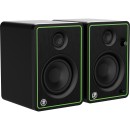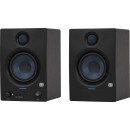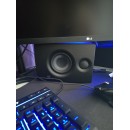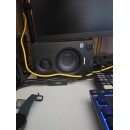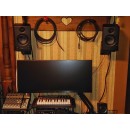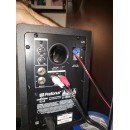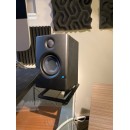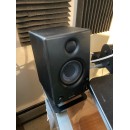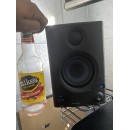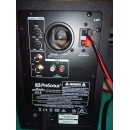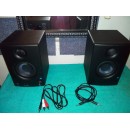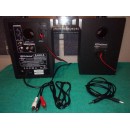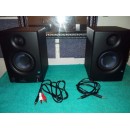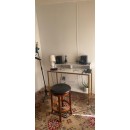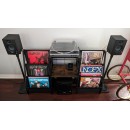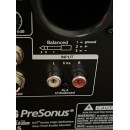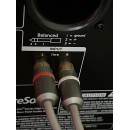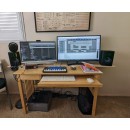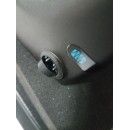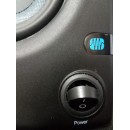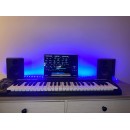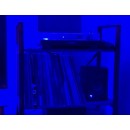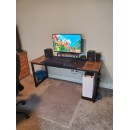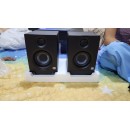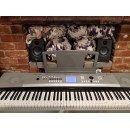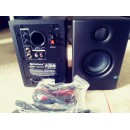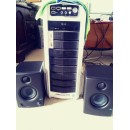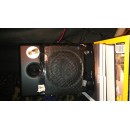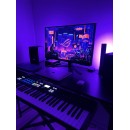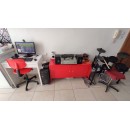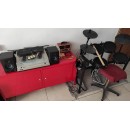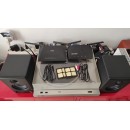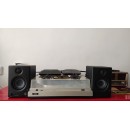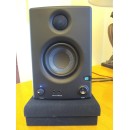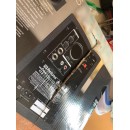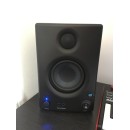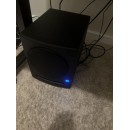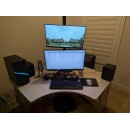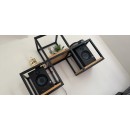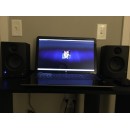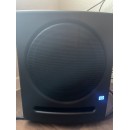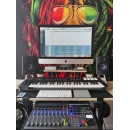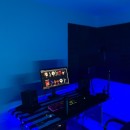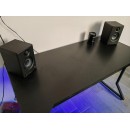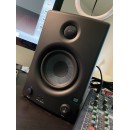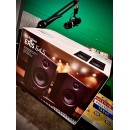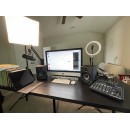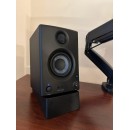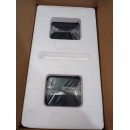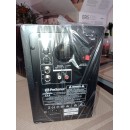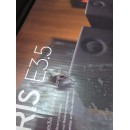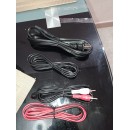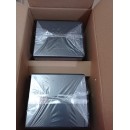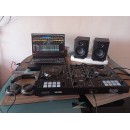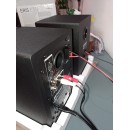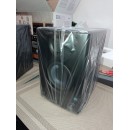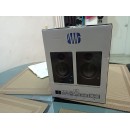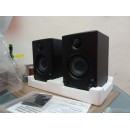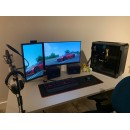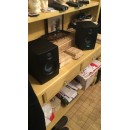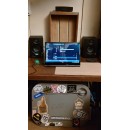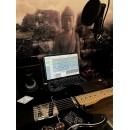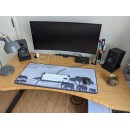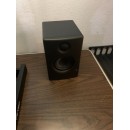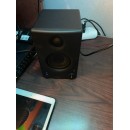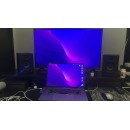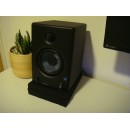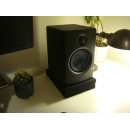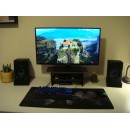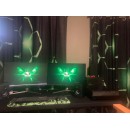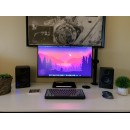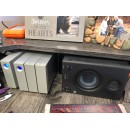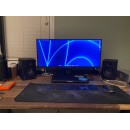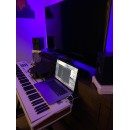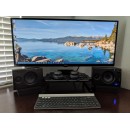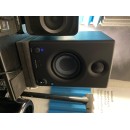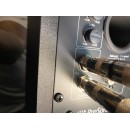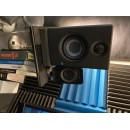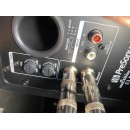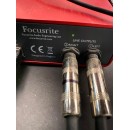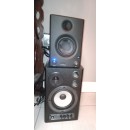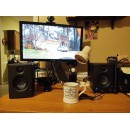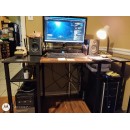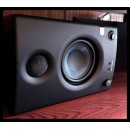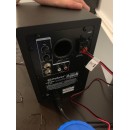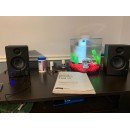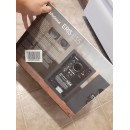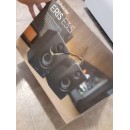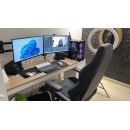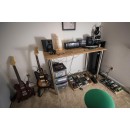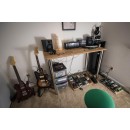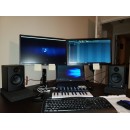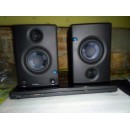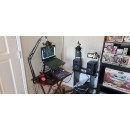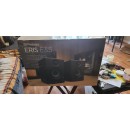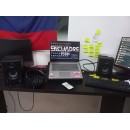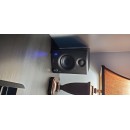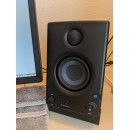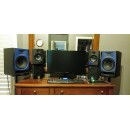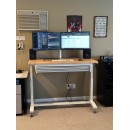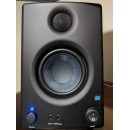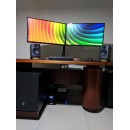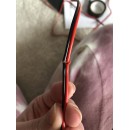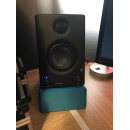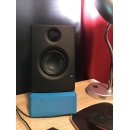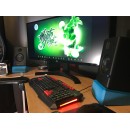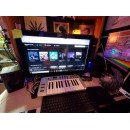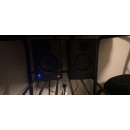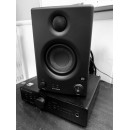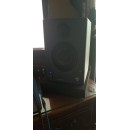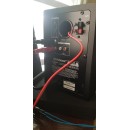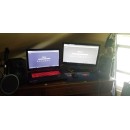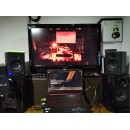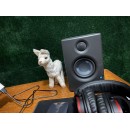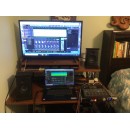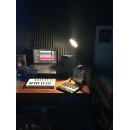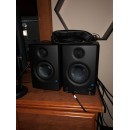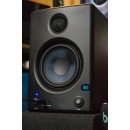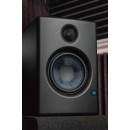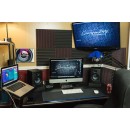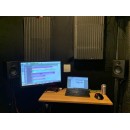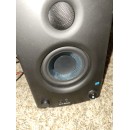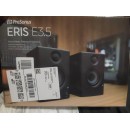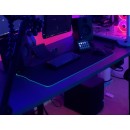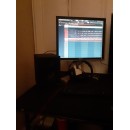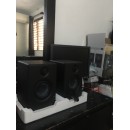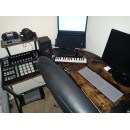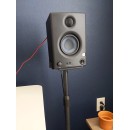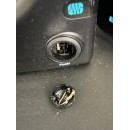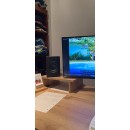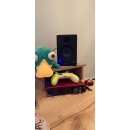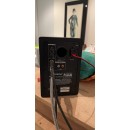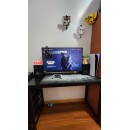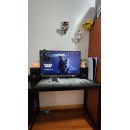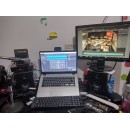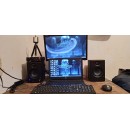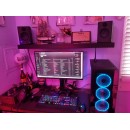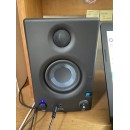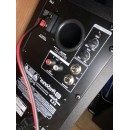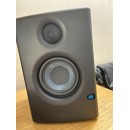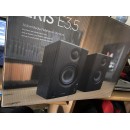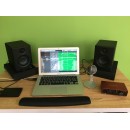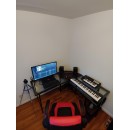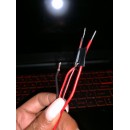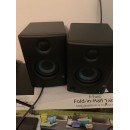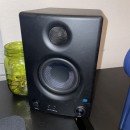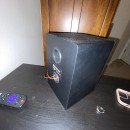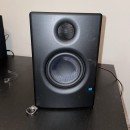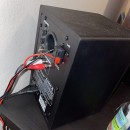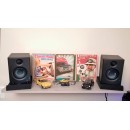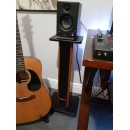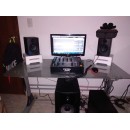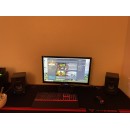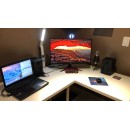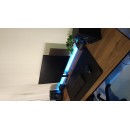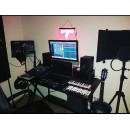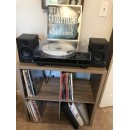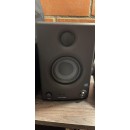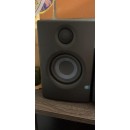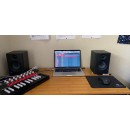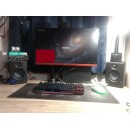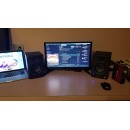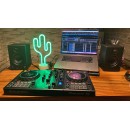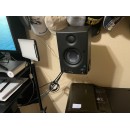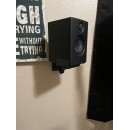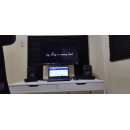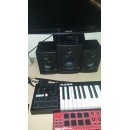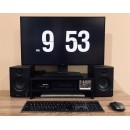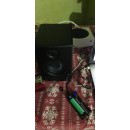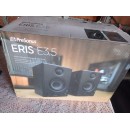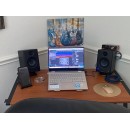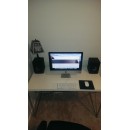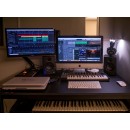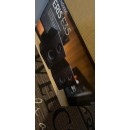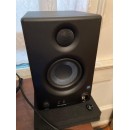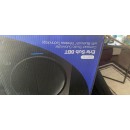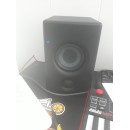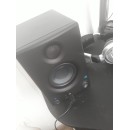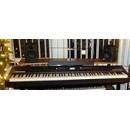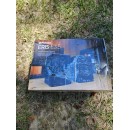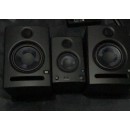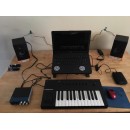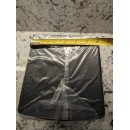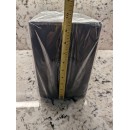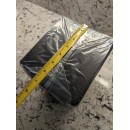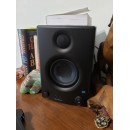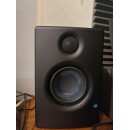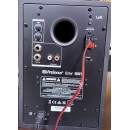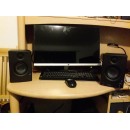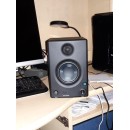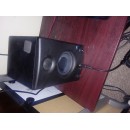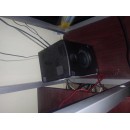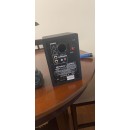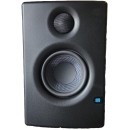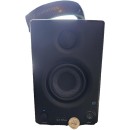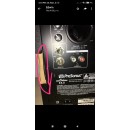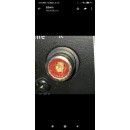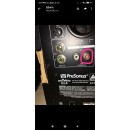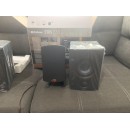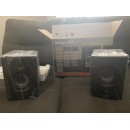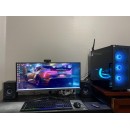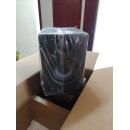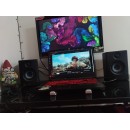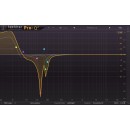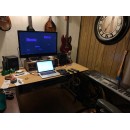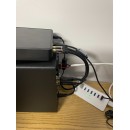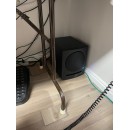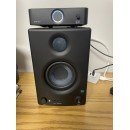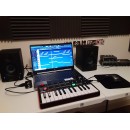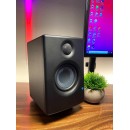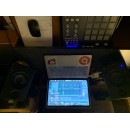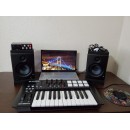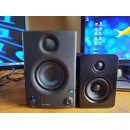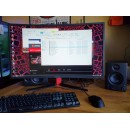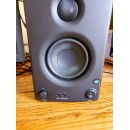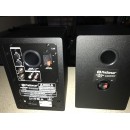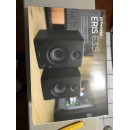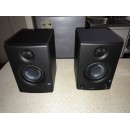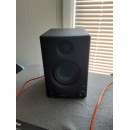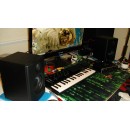Mackie CR4-XBT vs PreSonus ERIS 4.5BT: Which Studio Monitor is Right for You?
The Mackie CR4-XBT Studio Monitor Speaker and the PreSonus ERIS 4.5BT Studio Monitor Speaker are both excellent choices for those seeking quality audio monitoring. The Mackie CR4-XBT features a sleek and professional design with a classic black finish, making it a stylish addition to any studio setup. It boasts a power output of 50 watts and includes a 4-inch polypropylene-coated woofer and a 0.75-inch silk dome tweeter, delivering a balanced and clear sound. With built-in Bluetooth capability, these speakers allow for wireless streaming from any Bluetooth-enabled device, providing flexibility and convenience in audio playback.
On the other hand, the PreSonus ERIS 4.5BT Studio Monitor Speaker offers a slightly different approach. It includes a 4.5-inch Kevlar low-frequency driver and a 1-inch silk dome tweeter, providing a slightly broader sound range. The ERIS 4.5BT also features a 50-watt power output and includes Bluetooth connectivity for seamless wireless audio streaming. What sets the ERIS 4.5BT apart is its acoustic tuning controls, allowing users to adjust the high and low frequencies, making it ideal for customizing the sound to fit the specific acoustics of the room.
Both speakers cater to a wide range of user needs, from casual listeners to professional audio engineers. While the Mackie CR4-XBT offers a straightforward, user-friendly experience with its classic design and reliable sound, the PreSonus ERIS 4.5BT provides additional control for those who wish to fine-tune their audio experience. Ultimately, the choice between the two may come down to personal preference regarding design and the level of control one desires over their audio output.
In this comprehensive comparison, we will delve into the specifications, advantages, and disadvantages of the Mackie CR4-XBT and PreSonus ERIS 4.5BT studio monitor speakers. Our detailed analysis will guide you through every aspect of these products, helping you make an informed decision based on their unique features and performance metrics.
In-Depth Comparison of Mackie CR4-XBT and PreSonus ERIS 4.5BT
| User Rating Based on Analysis of Reviews | |
|---|---|
|
Show More |
| Pros: | |
|---|---|
|
|
| Cons: | |
|---|---|
|
|
| Find Best Price | Find Best Price |
| Key Specs | |
|---|---|
| Monitor Type & Configuration | |
| Active 2-Way | Active 2-Way |
| Total Power Output | |
| 50 W per Monitor | 25 W RMS per Monitor |
| Tweeter | |
| 1x 0.75" / 19.1 mm Silk Dome | 1x 1" / 25.4 mm Silk Dome |
| Woofer | |
| 1x 4" / 10.16 cm Polypropylene Cone |
1x 4.5" / 11.4 cm Cone |
| Frequency Range | |
| 60 Hz to 20 kHz (-10 dB) 65 Hz to 20 kHz (-3 dB) |
70 Hz to 20 kHz |
| Audio I/O | |
| 2x 1/4" TRS Balanced/Unbalanced Input 1x Stereo 2RCA Unbalanced Input 2x Push Terminal Unbalanced Output 1x 1/8" / 3.5 mm TRS Unbalanced Output |
2x 1/4" TRS Balanced Line Input 1x Stereo 2RCA Unbalanced Line Input 1x 1/8" / 3.5 mm TRS Unbalanced Line Input 1x 1/8" / 3.5 mm TRS Unbalanced Headphone Output 2x Push Terminal Passive Speaker Output |
| Digital Audio I/O | |
| Network I/O | |
| Wireless | |
| Bluetooth | Bluetooth |
The Mackie CR4-XBT Studio Monitor Speaker and the PreSonus ERIS 4.5BT Studio Monitor Speaker are both active 2-way studio monitors designed for audio professionals. The Mackie CR4-XBT features a total power output of 50 W per monitor, providing a more robust sound compared to the PreSonus ERIS 4.5BT, which has a total power output of 25 W RMS per monitor. This difference in power output can significantly impact the overall loudness and clarity of the sound, especially in larger spaces or during more dynamic audio playback.Show More
When it comes to driver configuration, the Mackie CR4-XBT is equipped with a 0.75" silk dome tweeter and a 4" polypropylene cone woofer, while the PreSonus ERIS 4.5BT features a 1" silk dome tweeter and a 4.5" cone woofer. The larger woofer in the PreSonus model may provide slightly better low-end response, but the smaller tweeter size in the Mackie could allow for a more refined high-frequency output. Both monitors cover a frequency range from 60 Hz to 20 kHz for the Mackie (with a -3 dB point at 65 Hz) and from 70 Hz to 20 kHz for the PreSonus, making them suitable for a wide range of audio applications.
In terms of audio I/O options, the Mackie CR4-XBT offers multiple connectivity options including 2x 1/4" TRS balanced/unbalanced inputs, a stereo 2RCA unbalanced input, and a 1/8" TRS unbalanced output, along with push terminal outputs. The PreSonus ERIS 4.5BT also includes 2x 1/4" TRS balanced line inputs, a stereo 2RCA unbalanced line input, and an 1/8" TRS unbalanced line input, along with a 1/8" TRS unbalanced headphone output. Both models lack digital and network audio I/O, but they do feature Bluetooth connectivity for wireless audio streaming, enhancing their versatility.
In summary, while both the Mackie CR4-XBT and PreSonus ERIS 4.5BT offer solid performance as studio monitors, the Mackie provides greater power output and potentially cleaner highs, whereas the PreSonus may excel with its slightly larger woofer for low-end response. The choice between the two will largely depend on the specific audio needs and preferences of the user.
| General | |
|---|---|
| Number of Included Monitors | |
| Stereo Pair | Stereo Pair |
| Enclosure | |
| Bass-Reflex/Ported | Bass-Reflex/Ported |
| Total Power Output | |
| 50 W per Monitor | 25 W RMS per Monitor |
The Mackie CR4-XBT Studio Monitor Speaker and the PreSonus ERIS 4.5BT Studio Monitor Speaker both come as a Stereo Pair, making them suitable for a variety of audio applications. This feature ensures that users can enjoy a balanced soundstage, which is crucial for accurate audio mixing and listening experiences. Both monitors utilize a Bass-Reflex/Ported enclosure design, enhancing their low-frequency response and providing deeper bass tones.Show More
In terms of power output, the Mackie CR4-XBT delivers a robust 50 W per Monitor, offering a more powerful audio performance compared to the PreSonus ERIS 4.5BT, which has a total power output of 25 W RMS per Monitor. This difference in power output can result in louder playback levels and potentially a greater dynamic range for the Mackie model, making it more suitable for larger spaces or for users who prefer higher volume levels.
Overall, while both the Mackie CR4-XBT and PreSonus ERIS 4.5BT share similar design features and configurations, the significant disparity in total power output positions the Mackie model as a more powerful option for those seeking enhanced audio performance in their studio or listening environments.
| Drivers per Monitor | |
|---|---|
| Tweeter | |
| 1x 0.75" / 19.1 mm Silk Dome | 1x 1" / 25.4 mm Silk Dome |
| Woofer | |
| 1x 4" / 10.16 cm Polypropylene Cone |
1x 4.5" / 11.4 cm Cone |
| Amplifiers | |
| Full-Range: 50 W Peak Class-D | Full-Range: 25 W RMS Class-AB |
The Mackie CR4-XBT Studio Monitor Speaker features a 0.75" silk dome tweeter and a 4" polypropylene cone woofer, providing a well-balanced sound profile suitable for various audio applications. Its 50 W Peak Class-D amplifier ensures powerful audio output, making it a great choice for users who require higher volume levels without compromising on sound quality. The speaker is designed for those looking for an affordable yet effective solution for studio monitoring.Show More
In contrast, the PreSonus ERIS 4.5BT Studio Monitor Speaker comes equipped with a 1" silk dome tweeter and a slightly larger 4.5" cone woofer, allowing for a broader frequency response. With a 25 W RMS Class-AB amplifier, the ERIS 4.5BT focuses on maintaining sound fidelity at moderate volume levels. It also boasts a frequency range of 70 Hz to 20 kHz and a maximum sound pressure level (SPL) of 100 dB, making it suitable for detailed audio work.
While both models include Bluetooth connectivity, the Mackie CR4-XBT emphasizes a straightforward approach to audio monitoring without additional features like EQ adjustments. In contrast, the PreSonus ERIS 4.5BT offers more extensive connectivity options, including multiple line inputs and a headphone output, along with high-frequency and low-frequency shelf EQ controls. However, the ERIS lacks phase adjustment capabilities, which might be a consideration for some users.
Overall, both the Mackie CR4-XBT and PreSonus ERIS 4.5BT provide solid performance as studio monitors, but they cater to slightly different needs and preferences. The Mackie model is ideal for users seeking a compact yet powerful speaker for various applications, while the PreSonus model appeals to those who prioritize connectivity options and customizable sound profiles.
| Power | |
|---|---|
| AC Input Power | |
| 100 to 240 VAC, 50/60 Hz | 100 to 240 VAC, 50/60 Hz |
The Mackie CR4-XBT Studio Monitor Speaker and the PreSonus ERIS 4.5BT Studio Monitor Speaker both feature similar power requirements, with an AC Input Power of 100 to 240 VAC and a frequency of 50/60 Hz. This allows for versatility in different regions, making both speakers suitable for international use without the need for additional transformers.Show More
In terms of power consumption, the Mackie CR4-XBT stands out with a consumption of 60 W. This indicates a higher power draw compared to many other speakers in its class, potentially resulting in a more robust audio output. On the other hand, the PreSonus ERIS 4.5BT does not specify its power consumption, which may affect its performance and efficiency compared to the Mackie model.
Overall, both studio monitors are designed to deliver quality sound for various audio applications. However, the Mackie CR4-XBT’s power consumption rating gives it a potential edge in performance reliability, while the PreSonus ERIS 4.5BT remains a strong contender in the market, especially for users who prioritize Bluetooth connectivity and flexibility in their studio setups.
| Physical | |
|---|---|
| Color | |
| Black | Black |
| Monitor Orientation | |
| Vertical | Vertical |
| Dimensions (W x H x D) | |
| 6.1 x 8.9 x 8.3" / 15.5 x 22.6 x 21.1 cm (Each) | 6.4 x 9.5 x 7" / 162.6 x 241.3 x 177.8 mm (Each) |
| Weight | |
| 10.1 lb / 4.6 kg (Pair) | 2.0 lb / 0.9 kg (Each) |
The Mackie CR4-XBT Studio Monitor Speaker features a sleek black color and is designed for vertical orientation. It is constructed from MDF, providing durability and a solid sound foundation. This model has no mounting points and operates effectively within a temperature range of 32 to 104°F (0 to 40°C). The dimensions of each speaker are 6.1 x 8.9 x 8.3 inches (15.5 x 22.6 x 21.1 cm), and the overall weight for the pair is 10.1 lb (4.6 kg).Show More
In comparison, the PreSonus ERIS 4.5BT Studio Monitor Speaker also comes in a black finish and features a vertical orientation. Unlike the Mackie model, the ERIS 4.5BT is not fan-cooled. Each speaker measures 6.4 x 9.5 x 7 inches (162.6 x 241.3 x 177.8 mm) and has an individual weight of 2.0 lb (0.9 kg), making it lighter than the Mackie pair. This model also lacks mounting points, similar to the CR4-XBT.
Both studio monitors offer robust construction and vertical orientation, making them suitable for studio environments. However, the Mackie CR4-XBT is heavier and larger, while the PreSonus ERIS 4.5BT is more compact and lightweight, catering to different user preferences based on space and portability needs.
| Packaging Info | |
|---|---|
| Package Weight | |
| 11.61 lb | 12.675 lb |
| Box Dimensions (LxWxH) | |
| 16.8 x 11 x 9" | 19.2 x 13.4 x 9.6" |
The Mackie CR4-XBT Studio Monitor Speaker boasts a package weight of 11.61 lb, making it a lightweight option for those looking for portability and ease of setup. The box dimensions measure 16.8 x 11 x 9", which provides a compact design suitable for various studio spaces, ensuring it can fit comfortably on desks or shelves without taking up too much room.Show More
In comparison, the PreSonus ERIS 4.5BT Studio Monitor Speaker has a slightly heavier package weight of 12.675 lb, which could indicate a more robust build quality. Its box dimensions are larger at 19.2 x 13.4 x 9.6", giving it a bigger footprint. This might be beneficial for those who prefer a more substantial presence in their studio environment, but it could also mean less flexibility in smaller spaces.
Overall, while both studio monitors serve the purpose of providing quality sound, the Mackie CR4-XBT is more compact and lightweight, ideal for mobile setups or limited spaces. On the other hand, the PreSonus ERIS 4.5BT offers a slightly heavier and larger option, which may appeal to users looking for a more durable and pronounced studio monitor experience.
| Customer Images | |
|---|---|
